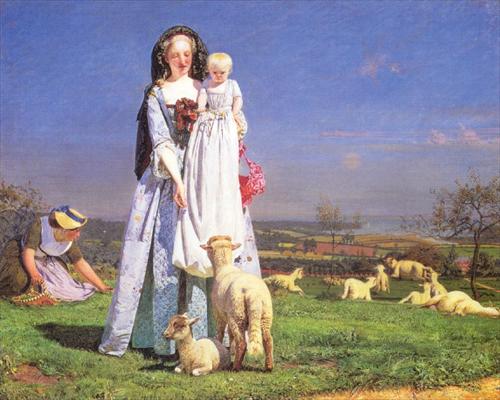Ford Madox Brown was born in Calais, he and his wife did not move to live in England until 1844, his wife died two years later. The painter became closely linked to The Pre-Raphaelite Brotherhood founded in London in 1848 by James Collinson, William Holman Hunt, John Everett Millais and Dante Gabriel Rossetti, these artists were a well organised team who promoted their work in a journal they published named The Germ. Five years later the group disbanded and each artist went his own way, by then the group had expanded. Again we see how artists have found news means of expression, they rebelled against the art establishments like the Royal Academy and the public was shocked by their work when they depicted religious figures in every day occupations, Jesus in a carpenter’s workroom for example. They were described as the ‘first British avant garde’ in their case they looked back to earlier art, paintings executed before Raphael, their defiance was a catalyst for change, Ruskin, the art critic gave their work critical acclaim, they courted the nouveau riche who bought their work.
In Pretty Baa Lambs we have another work about motherhood but as the title suggests young animals are also part of the subject matter, Brown’s wife and daughter were his models, we can imagine the mother saying, ‘daughter, look at the pretty baa lambs’ as they gaze down, nearby a young woman gathers something from the grass, he may have dressed the figures in 18th.century clothes in order to hark back to a time before Industrialisation was in full swing, he must have known that Clapham Common, where the scene was mostly painted, would change beyond recognition. He worked in the open air before the Impressionists decided to do so, he also worked in his garden in nearby Stockwell. Using a restricted palette of mainly blue, white and green with an important flash of red, he records for us a memory of a scene reaching into the far distance stretching across fields, I like the big sky, the openness and space created. There is a wistfullness too I think, both his wives had babies who died young. His work often carried a moral message, with William Morris he founded the Hogarth club, he died in 1893 and was given a secular funeral, his second wife had died two years before.


I like the work of Ford Madox Brown, and was lucky enough to see an exhibition of his work in Manchester not long ago. However, I can’t say that this one is my favourite, as it seems a bit sentimental to me, though I like the light in it. My favourite Brown painting is ‘Work’, which I put on the cover of my book ‘A New Buddhist Ethics’: see http://uploads5.wikiart.org/images/ford-madox-brown/work-1863.jpg. He’s also good at Englishness, as in ‘An English Autumn Afternoon’ http://i.telegraph.co.uk/multimedia/archive/02013/ford6_2013885i.jpg or the famous ‘Last of England’, which captures the melancholy of emigrants http://uploads2.wikiart.org/images/ford-madox-brown/the-last-of-england-1860.jpg .
Hi Robert,
I agree with your comments, this painting is not typical of Ford Madox Brown’s work, I was ‘stuck’ on the theme of maternity, fresh ground next time!